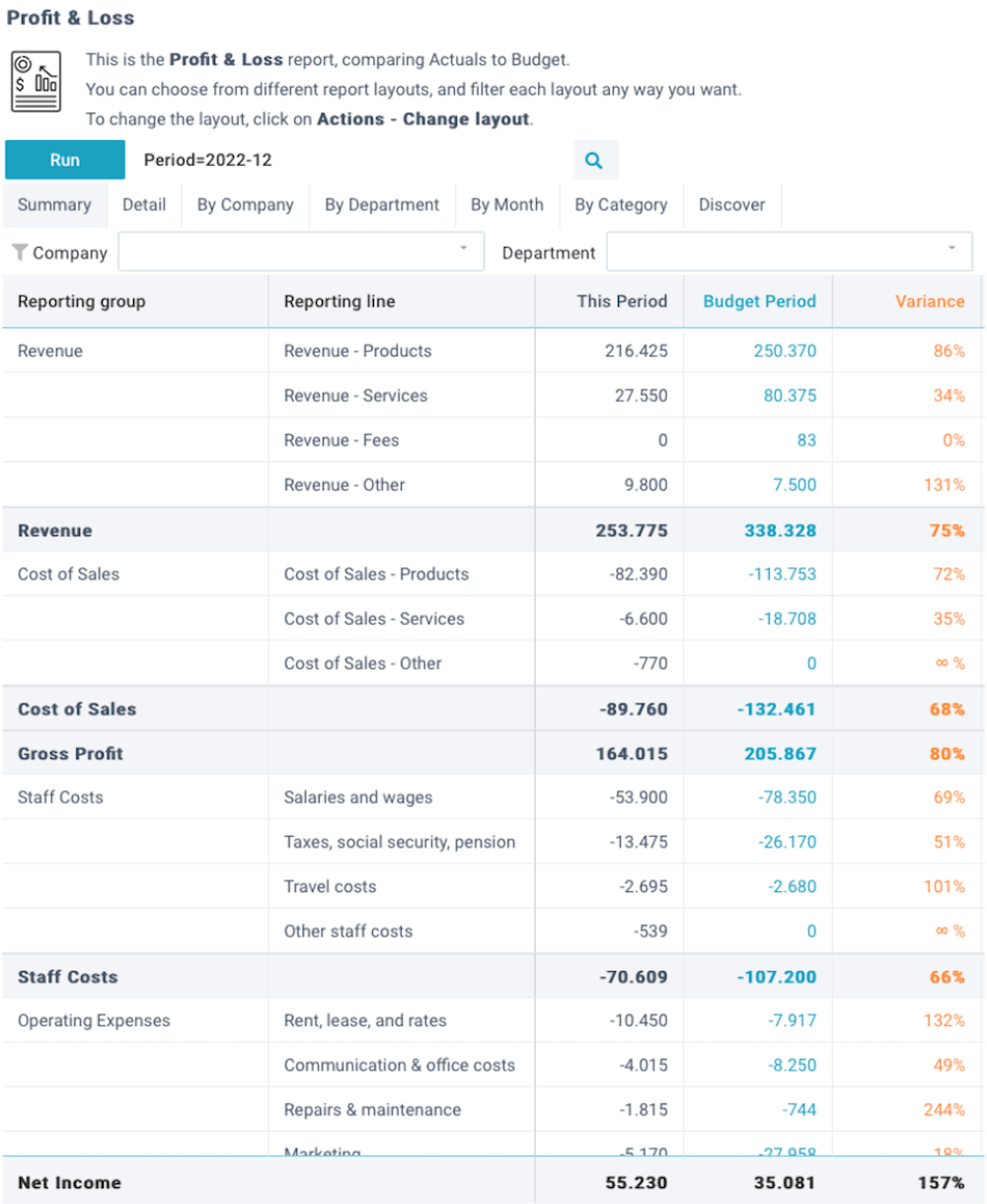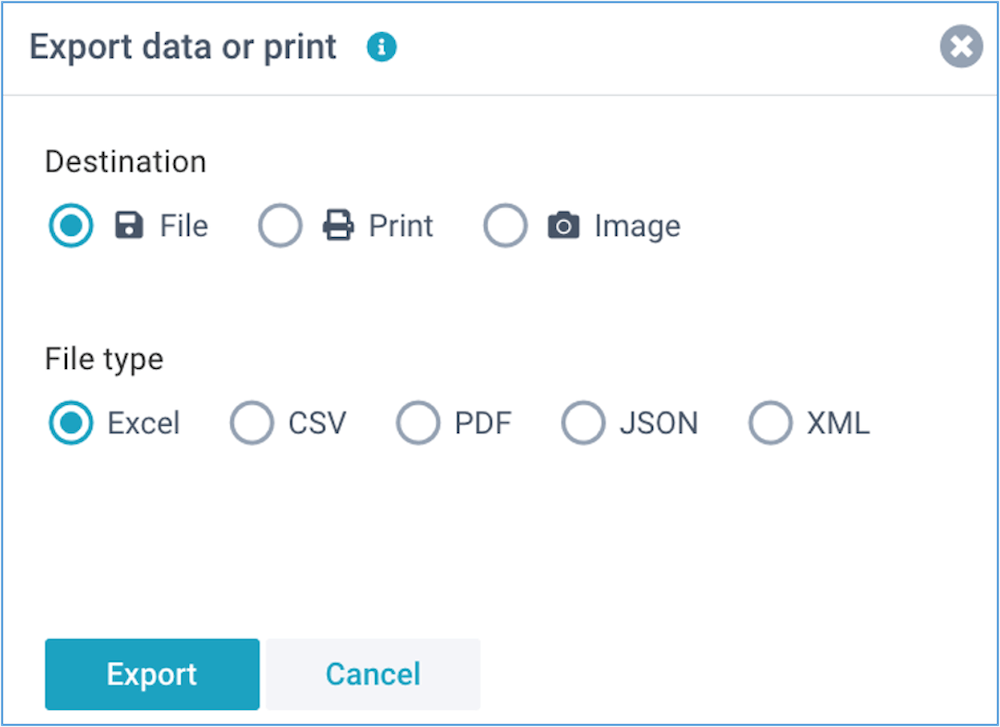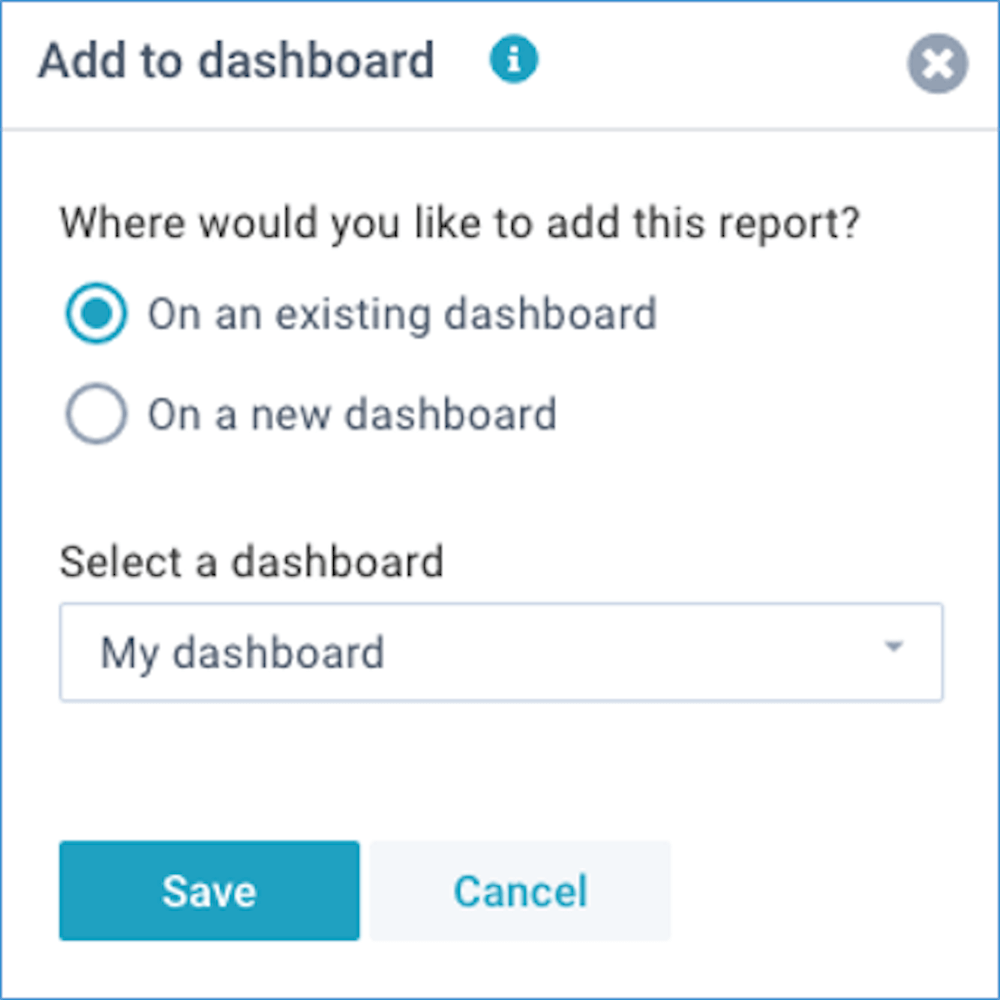Run reports
This option enables you to run defined reports. After you have a selected a report (and any selection parameters where applicable), you can view the report.
You can also watch the tutorial video.
Reports can have multiple named layouts. If a report has more than 1 layout, the layout names will be shown horizontally, and you can easily switch between them by clicking on the layout names.

- Click on ☰ XLReporting in the left-top of the screen to minimize the menu area and maximize the report area. Clicking again will restore it to the way it was.
- If you experience any issues with scrolling in reports, change your browser settings.
Actions
When running a report, you can use the Actions button in the right-top of the screen:

This button opens a dropdown menu with further options:
- Find text in report (or Ctrl+F)
- Change this layout
- Export data or print
- Run AI assistant
- Add to dashboard
- Define this report
Find text
By pressing Ctrl+F or selecting Actions - Find text, you can search the contents of the report. As soon as you start typing text, the data will be filtered on any rows that match your search text, and matching rows are clearly marked with a background color.
Change this layout
It is easy to edit a report layout, simply by dragging fields into the various areas of a report. Click on Actions - Change layout to edit the current report layout.
There are 2 types of changes. You can always make an ad-hoc (one-time) change, which only persists while you stay on this report, and is only visible to you, not to other users. Depending on your user permissions, you may also be allowed to save your changed layout. This means it effectively replaces the current layout and will be visible to all other users.
By default, changing a report layout is ad-hoc, meaning the layout is only available to you, on this page. When you navigate to another menu item, the layout is not saved. If you have the Save layout permission, you are also allowed to add new layouts, and save your changed layouts so they are available to other users.

This window enables you to change the report options and the fields position (watch the tutorial video).
Report options
These are settings that determine the overall appearance of the report layout:
- Layout type - report, compact, sparklines, chart, treemap, diagram
- Chart type - column, column (stacked), column (with line), column (combi), bar, bar (stacked), line, line (smooth), pie, pie (3D), donut, donut (KPI), area, area (smooth), area (stacked), radar, scatter, gauge, bullet, scorecard, geo chart, timeline
- Column totals - sum, average, variance, variance (-), or none
- Report totals - sum, average, result, result (-), or none
- Sort by - sort either on the descriptions in the row fields (if you select multiple Row fields, these will all be included in the sort operation), or on the values in the report
- Options - dependent on the selected layout type, you can enable the
following options:
- Totals first - show the column totals before the data columns
- Incremental - calculate the incremental value (difference) between subsequent column values (converting cumulative column values to distinct values)
- Cumulative - calculate the cumulative totals from subsequent column values (converting distinct column values to cumulative values)
- Fin subtotals - insert extra subtotals in Profit & Loss and Balance Sheet reports: "Gross Profit", "Earnings before Interest & Tax", "Total Assets", and "Total Equity & Liabilities". In all other reports, this option will be ignored
- Hide zeros - for reports, hide rows that only have zero values
- Collapse - for pivot reports, collapse all rows
- Show grid - for charts, show horizontal grid lines
- Hide values - for charts, hide the values on the axis
- Reverse values - for charts, reverse the data values
- Labels for totals - you can optionally provide 1 or more labels for the report totals, column totals, and subtotals. By default, the totals are given an automated label based on the selected operation (e.g. Total, Average, Variance etc). You can optionally specify a custom label. For example, instead of the default "Total" you might want to show "Net result" as a report total. This field can contain up to 6 labels (Report totals, Column totals, Subtotals, Fin subtotals 1-3), separated by a comma, and they are all optional
- Zones - for the chart types "gauge", "bullet", and "scorecard", you can optionally enter the % values for the 3 zones (green, orange, red), separated by a comma (zones are used when comparing 2 value fields)
- Goals - for the chart types "gauge", "bullet", and "scorecard", you can optionally enter the absolute value for target, and (optionally) the mininum and maximum values, separated by a comma
You can choose from over 30 different layout types.
Fields position
You can manually drag-and-drop any of the available fields into any of the report areas, and if you no longer want a field in your report, you can simply drag it out again.
- Fields - this shows all fields that are available within this report.
- Filters - drag fields here that you want to use as dynamic filters. They will be shown above the report with automatic lists of values. Whenever you select a different filter value, the report will be immediately updated to reflect this.
- Rows - drag fields here that you want to lay out into rows. This is the main dimension of your report. You can create a grouping in your report by dragging multiple fields here, and move them into the desired order. For the standard layout type, you can also indicate where you want subtotals.
- Columns - drag fields here that you want to lay out into columns. Usually, these are fields that contain a period, date, or time. By including one or more fields into columns, you can create two-dimensional reports.
- Values - drag fields here that you want to summarize on. Usually, these are
number or amount fields. Once you have dragged a field here, you can click on it to select
the color and the type of operation.

You can choose from these operations:- Sum - the sum of all values (non-numeric values are ignored).
- Count - the number of values that are not blank (values can be numeric or text). Please note that this counts the visible items in the report, and not all items in the underlying data.
- Average - the average of all values (non-numeric values are ignored).
- Distinct - the sum of distinct values in the underlying data.
- Minimum - the smallest value (values can be numeric or text).
- Maximum - the largest value (values can be numeric or text).
- Percentage - the percentage (%) that each value makes up of the report total (non-numeric values are ignored). The report total is always 100%.
- Incremental - the incremental value (difference) between the rows.
- Cumulative - the cumulative value for every row.
You can also watch the tutorial video.
Export data or print
All reports in XLReporting can be exported to Excel, PDF, JSON, XML, CSV, as well as be
printed.
Please note that this option is only visible if your user role has Export
data permissions.

AI assistant
The AI assistant can automatically analyse your report and generate a written response. For
example, you can request a "summary of revenue" or an "analysis of profit & loss". Please refer
to Run AI assistants for more information.
Please
note that this option is only visible if your user role has Run AI assistant
permissions.
Add to dashboard
A dashboard is a personal page with your own favorite reports and models. You can create multiple dashboards, and each dashboard can contain multiple reports or models (watch the tutorial video).
Click on Actions - Add to dashboard to add this report to either a new dashboard, or to a new dashboard:
